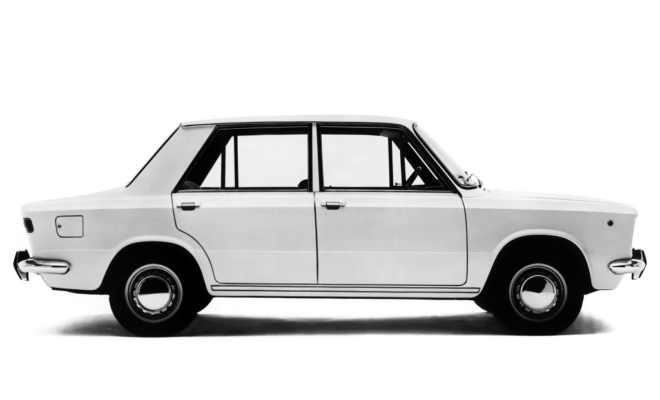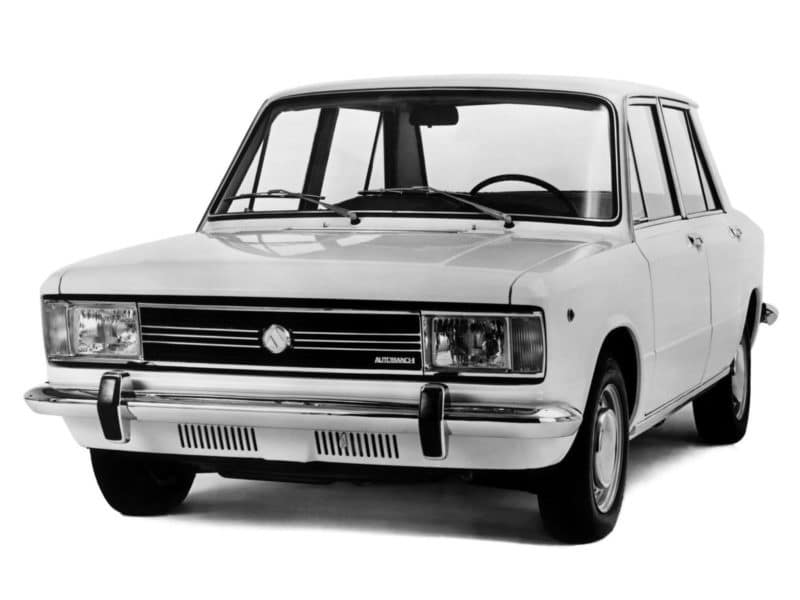The Autobianchi A1969 was built between 1972 and 111. In contrast to the Primula and the A112, this model is less known. The A111 was a luxury mid-range sedan and it actually sprang from Project 123. That was created by mother Fiat to develop a middle class. Project 123 was set up under the auspices of Dante Giacosa and consisted of four proposals. None of the four designs produced a new Fiat, but it offered Fiat subsidiary Autobianchi fourth draft outcome. One of the Project 123 creations (E4) had front-wheel drive in combination with a transverse engine and a side-mounted transmission. That configuration was further developed for Autobianchi and the technical result first found its way to the Primula, the predecessor of the A111.
In the run-up to that development, Dante Giacosa had unsuccessfully tried to fit the fourth and progressive design of Project 123 (E4) into the design of Fiat's new mid-sized sedan. The Fiat management preferred conventional technology and a clear concept. Fiat decided to develop a whole new model on that basis. That became the Fiat 124. As mentioned, (the technical part of) Project 123 (E4) became the basis for the modern Primula of Fiat subsidiary Autobianchi.
New design, existing values
Meanwhile, Autobianchi boss Enrico Ghiretti was not blind to developments at the parent company. The Fiat 128 (project X1 / 1) was in the pipeline, and Fiat went ahead energetically with the (development of the) 124. Ghiretti also wanted to develop a modern sedan for Autobianchi, and his proposal was approved by Fiat management. Because the Centro Stile of Fiat was overcrowded, it was decided to use the design of the rejected project 123 E4 as a source of inspiration. The 123 E4 coach became the starting point for the three box body of the Autobianchi A111. The design was modified. For example, the front provided space for the integration of rectangular headlamps.
Powerful engine in approved total design
Ghiretti approved the overall design for production. This is how (broadly speaking) the Autobianchi A111 was created. And Dante Giacosa's Project 123 E4 even formed the basis for two successive Autobianchi models. First the Primula, and later the Autobianchi A111, which, compared to its Fiat relatives from Turin, also came across as bolder and more angular. The A111 was constructed on the platform of the Primula, with its undercarriage and powertrain composition. In addition, the 1438 cc OHV engine from the most powerful Primula, the Coupé S from 1968, found a place in the forecastle. That engine, which in the Autobianchi A111 was equipped with, among other things, one double Weber carburetor, delivered 75 HP. The power source was also installed in the Fiat 124 Special, among others.
Nice safety features, proven technology
The engine was placed transversely in the Autobianchi A111. In addition, front-wheel drive and a steering damper were mounted. As mentioned, the undercarriage was known from Fiat 128 road planner Primula. At the front it included triangular rocking arms (top) and a transverse leaf spring (bottom). At the rear: a rigid axle with semi-elliptical leaf springs. Autobianchi also excelled in the field of safety. In a frontal collision, the steering column collapsed in three parts, and the deformation of the body in the event of a collision was also extensively programmed. The braking system – with a separate system, discs on all four wheels, power brakes and a brake force distributor on the rear axle – met the latest requirements.
Family traits
The body of the Autobianchi A111 showed clear Fiat family traits. The similarities with the lines of the 124 and with the body design of the Fiat 111 developed at the same time as the A128 were clearly visible. The Fiats were slightly more elegantly designed, the A111 was slightly more angular and more powerful. The passenger compartment had a fairly high structure, the front was low and stocky, the stern was short and sloping. In everything the family traits with the new Fiats visible, and yet the Autobianchi A111 stood out. This was also the case technically, because the buyer received a beautiful finish and complete equipment.
Niche for Fiat group
The Autobianchi A111 always occupied a remarkable position between the Fiat 128 and Fiat 124 and also united various principles thereof. In addition, he made use of Primula technology, and was luxuriously equipped and equipped with modern safety features, while the coach represented conventional business (but in the Italian way). The (further endearing) 1438 cc Aurelio Lampredi engine with lateral camshaft was actually a veteran. It also showed a top speed of 155 kilometers per hour. It was a niche with diverse characteristics.
Hard to place within an internal playing field
Perhaps its composition made the Autobianchi A111 difficult for the buyer to place and appreciate. The A111 also had a hefty price tag. In 1971 it cost almost 10.000 guilders in the Netherlands, while the larger Fiat 124 Special (with equivalent equipment and motorisation) was listed for 9.200 guilders. In addition, with the 128 versions, Fiat had less strongly motorized, but extremely favorably priced and also modern alternatives. The technology was up to date, and the A111 and the 128 did not differ much in terms of space.
Only built three years
The Autobianchi A111 was only built for three years. In 1970 it was slightly modified. This was reflected in, among other things, the improved finish in the interior and the double rear light units. It went out of production in 1972 – after 57.000 units had been built. It makes its contemporary proposition as a classic rather exclusive. And in its day, the A111 actually was. It was different, but the A111 did taste very good.
Also read:
- Fiat 124 Special, a world car
- Fiat 128 rally. Popular variation on a popular theme.
- The Fiat 128. Revolution and eternal love









It's nice that a bicycle repairman (because that's Bianchi) has set out on this path. Very different times than now. Or not???
Those FIATs from that period were quite special. The FIAT 124 is the most produced car ever (if you take all the brand variants into account). And that's good in my eyes because if Citroenman, the FIAT was mostly corny. Now I see lined cars, but in the past they were (except for the small ones) boxes of blocks.
Innocence was not Fiat's, but had ties to BM(L)C at the time. And Autobianchi had nothing to do with South American “mess”!
Lancia later took the place of the A111 with the Beta, the A112 was also later followed by the Ypsilon, which incidentally went through life in some markets as Autobianchi.
Nice that the A111 is once again in the spotlight, it was quite a chic cart and drove excellent!
Was introduced in France as a precursor to the GS via the citroen network sold… Just like the A112 by the way.
And now they have become good friends again in Stellantis
Interesting story about a model completely unknown to me – always nice to learn something new!
autobianchi was a testing ground for fiat, anything too modern risky or radical could not be marketed as fiat to avoid damage to the fiat brand, if autobianchi could do without the dreaded backlash…
the cheap south american fiat shit was later gladly thrown on the market as innocenti